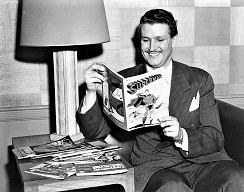
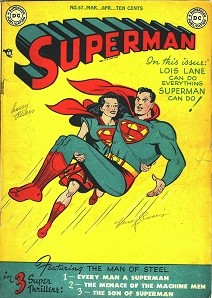 The Adventures of Superman (1940-1951) aired “The Mystery of the Ten Thousand Dollar Ghost” on March 4, 1949 as the 12th episode of its Mutual run in the 1949 season (all of which from February 7th to June 24th were of the half hour variety as opposed to the many multi-part, 15-minute serials that ran through most of the 1940s). Since we’ve showcased only four other episodes of this program (the last being from April of this year, 2022) I felt it would be helpful for newcomers to this fun adventure series if I reprised the generic background information that preceded those other episodes.
The Adventures of Superman (1940-1951) aired “The Mystery of the Ten Thousand Dollar Ghost” on March 4, 1949 as the 12th episode of its Mutual run in the 1949 season (all of which from February 7th to June 24th were of the half hour variety as opposed to the many multi-part, 15-minute serials that ran through most of the 1940s). Since we’ve showcased only four other episodes of this program (the last being from April of this year, 2022) I felt it would be helpful for newcomers to this fun adventure series if I reprised the generic background information that preceded those other episodes.
(Cover above left: Superman #57, March/April 1949.)
The Superman character, created by Jerry Siegel and Joe Shuster, first appeared in Action Comics #1, dated June 1938. That superhero strip in the comic was one of several strips in that now famous first issue, but turned out to be popular enough that a newspaper comic strip debuted in 1939. It also proved immensely popular, popular enough that a stand alone comic book was spun off and added to the ever-growing franchise, with the now iconic title of Superman #1, with a cover date of Summer 1939 (cover below left).
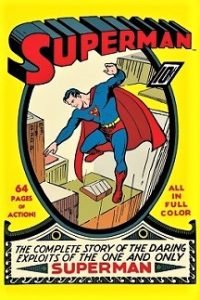 But the comic strip and magazine were only the beginning for the Man of Steel. Things were moving quickly, and as Wikipedia explains: “The serial came to radio as a syndicated show on New York City’s WOR on February 12, 1940. On Mutual, it was broadcast from August 31, 1942, to February 4, 1949, as a 15-minute serial, running three or, usually, five times a week. From February 7 to June 24, 1949, it ran as a thrice-weekly half-hour show. The series shifted to ABC Saturday evenings on October 29, 1949, and then returned to afternoons twice a week on June 5, 1950, continuing on ABC until March 1, 1951. In all, 2,088 original episodes of The Adventures of Superman aired on American radio.” Wikipedia also notes that many of the elements that have become staples of Superman’s fictional world were first introduced in the radio show, among them kryptonite, Daily Planet editor Perry White, copy boy (later cub reporter) Jimmy Olsen, and police inspector Bill Henderson. Also worthy of mention is the first meeting between Superman and Batman (and Robin) which took place in the March 2, 1945 episode.
But the comic strip and magazine were only the beginning for the Man of Steel. Things were moving quickly, and as Wikipedia explains: “The serial came to radio as a syndicated show on New York City’s WOR on February 12, 1940. On Mutual, it was broadcast from August 31, 1942, to February 4, 1949, as a 15-minute serial, running three or, usually, five times a week. From February 7 to June 24, 1949, it ran as a thrice-weekly half-hour show. The series shifted to ABC Saturday evenings on October 29, 1949, and then returned to afternoons twice a week on June 5, 1950, continuing on ABC until March 1, 1951. In all, 2,088 original episodes of The Adventures of Superman aired on American radio.” Wikipedia also notes that many of the elements that have become staples of Superman’s fictional world were first introduced in the radio show, among them kryptonite, Daily Planet editor Perry White, copy boy (later cub reporter) Jimmy Olsen, and police inspector Bill Henderson. Also worthy of mention is the first meeting between Superman and Batman (and Robin) which took place in the March 2, 1945 episode.
Bud Collyer (1908-1969, photo top right) was the voice of Clark Kent and Superman on radio, lowering his voice slightly when speaking as the Man of Steel. He is arguably best known, however, as the host of the popular television game shows of the 1950s, Beat the Clock and To Tell the Truth.
Joan Alexander (1915-2009, birth name Louise Abrass) played the spunky Lois Lane character for more than one thousand episodes of the program’s 11-year run.
From 1940-47 Jack Kelk (1923-2002) would play Jimmy Olsen, and from 1948-1950 it was Jack Grimes (1926-2009) who would play Jimmy Olsen. An interesting bit of trivia concerning Grimes is that though he was an old man of 22 when he began playing Jimmy Olsen, by the age of 12 he was acting in 35-40 radio shows a week. Grimes also worked in film and television in later years. A film of note in which he appeared was 1945’s noir crime film Lady on a Train (starring Deanna Durbin and Ralph Bellamy), based on the Leslie Charteris story. His television work included roles in Tom Corbett, Space Cadet, Maude, and All in the Family.
(Left: Joan Alexander – Center: Jack Kelk – Right: Jack Grimes)
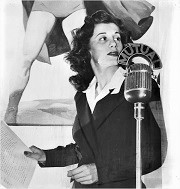

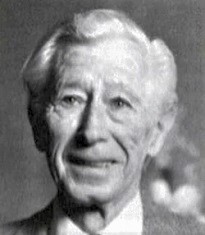
Anyone living in the home computer era and who has owned, or at the present moment currently owns one, is familiar with receiving unwanted “spam” email, notably a scam from some generic Nigerian Prince writing that you have been selected to receive a vast sum of money, the only sticking point is that they need your bank account number so they can deposit your money. Or a variation claiming you have won an incredible sum of money but some made up “fee” or “deposit” from your bank to theirs is necessary to facilitate the transfer of funds. It is a swindle, a scam, as old as the hills and with as many variations as there are stars in the heavens. One such variation is the premise for this week’s Superman episode. A number of wealthy citizens have received what appears to be an official letter from the Bank of Nugget City, letting the recipient know that a supposed lost relative (an orphaned child) from World War II has been found and all that is needed to save the youngster and give them a home is a mere $10,000. The problem is that once the kind-hearted but gullible men have departed for Nugget City with $10k in order to save the young child, they have never returned. One thing leads to another, and among the early facts coming to light is that Nugget City has been a ghost town for nearly half a century. This, of course, piques Clark’s interest and the game is afoot, and a frighteningly dark game it turns out to be, even with Superman’s help.
Play Time: 28:29
{Airing on a Friday evening, this episode of Superman was the third and final one of the week, the previous two broadcast on Monday and Wednesday. This made for perfect timing, as the neighborhood gang could hit the nearby newsstand early the next morning, still jazzed from this episode featuring the Man of Steel, the ultimate Good Guy. Good Guys vs. Bad Guys were easy to come by in many detective or mystery pulps in the 1940s and the neighborhood gang found quite a selection from which to choose. Dime Mystery Magazine (1932-50) began filling its pages with more or less regular crime fiction, but when returns showed lackluster sales figures it switched its format to one of “weird menace” after only ten issues. The publisher had hit the sweet spot with readers and the magazine’s 18-year run was proof of the publisher’s timely change of direction. It was a bi-monthly in 1949. New Detective Magazine (1941-53) focused its fiction around police detectives and found a regular following for 12 years. It then merged with Detective Tales and changed its title to Fifteen Detective Stories in August of 1953. That merger lasted but 12 issues, at which time the publisher changed the focus of the magazine entirely to that of a men’s magazine with the title True Adventures. New Detective was a bi-monthly in 1949. The Phantom Detective (1939-53) appealed to those readers who enjoyed a quasi-superhero element to their detective fiction, and who were also fans of the Shadow. In fact, it was launched to directly compete with Street & Smith’s The Shadow magazine. Until December of 1941 (the beginning of WWII for the U.S.) The Phantom Detective held to a solid monthly schedule, but then became erratic as it fought paper shortages and tight money supplies during the war. It rarely held to any set schedule for more than 2 years. In 1949 it managed 5 issues as it transitioned from a bi-monthly (6 issues in 1948) to a quarterly (4 issues in 1950).}
[Left: Dime Mystery, 2/49 – Center: New Detective, 3/49 – Right: Phantom Detective, 3/49]
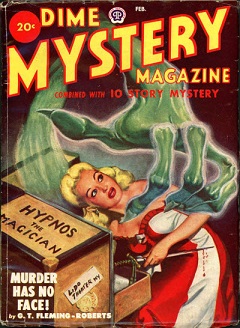
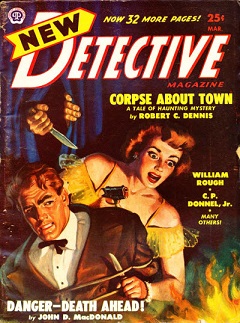
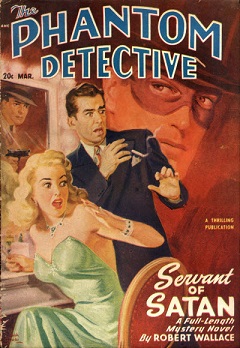
To view the entire list of weekly Old Time Radio episodes at Tangent Online, click here.